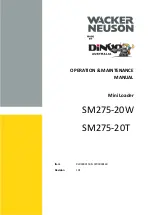
FOREWORD
HANDLING ELECTRIC EQUIPMENT AND HYDRAULIC COMPONENTS
WA470-6, WA480-6
00-11
C. Disconnections in wiring
If the wiring is held and the connectors are pulled apart, or com-
ponents are lifted with a crane with the wiring still connected, or
a heavy object hits the wiring, the crimping of the connector
may separate, or the soldering may be damaged, or the wiring
may be broken.
D. High-pressure water entering connector
The connector is designed to make it difficult for water to enter
(drip-proof structure), but if high-pressure water is sprayed
directly on the connector, water may enter the connector,
depending on the direction of the water jet. Accordingly, take
care not to splash water over the connector. The connector is
designed to prevent water from entering, but at the same time, if
water does enter, it is difficult for it to be drained. Therefore, if
water should get into the connector, the pins will be short-cir-
cuited by the water, so if any water gets in, immediately dry the
connector or take other appropriate action before passing elec-
tricity through it.
E.
Oil or dirt stuck to connector
If oil or grease are stuck to the connector and an oil film is
formed on the mating surface between the male and female pins,
the oil will not let the electricity pass, so there will be defective
contact. If there is oil or grease stuck to the connector, wipe it
off with a dry cloth or blow it dry with compressed air and spray
it with a contact restorer.
★
When wiping the mating portion of the connector, be care-
ful not to use excessive force or deform the pins.
★
If there is oil or water in the compressed air, the contacts
will become even dirtier, so remove the oil and water from
the compressed air completely before cleaning with com-
pressed air.





































